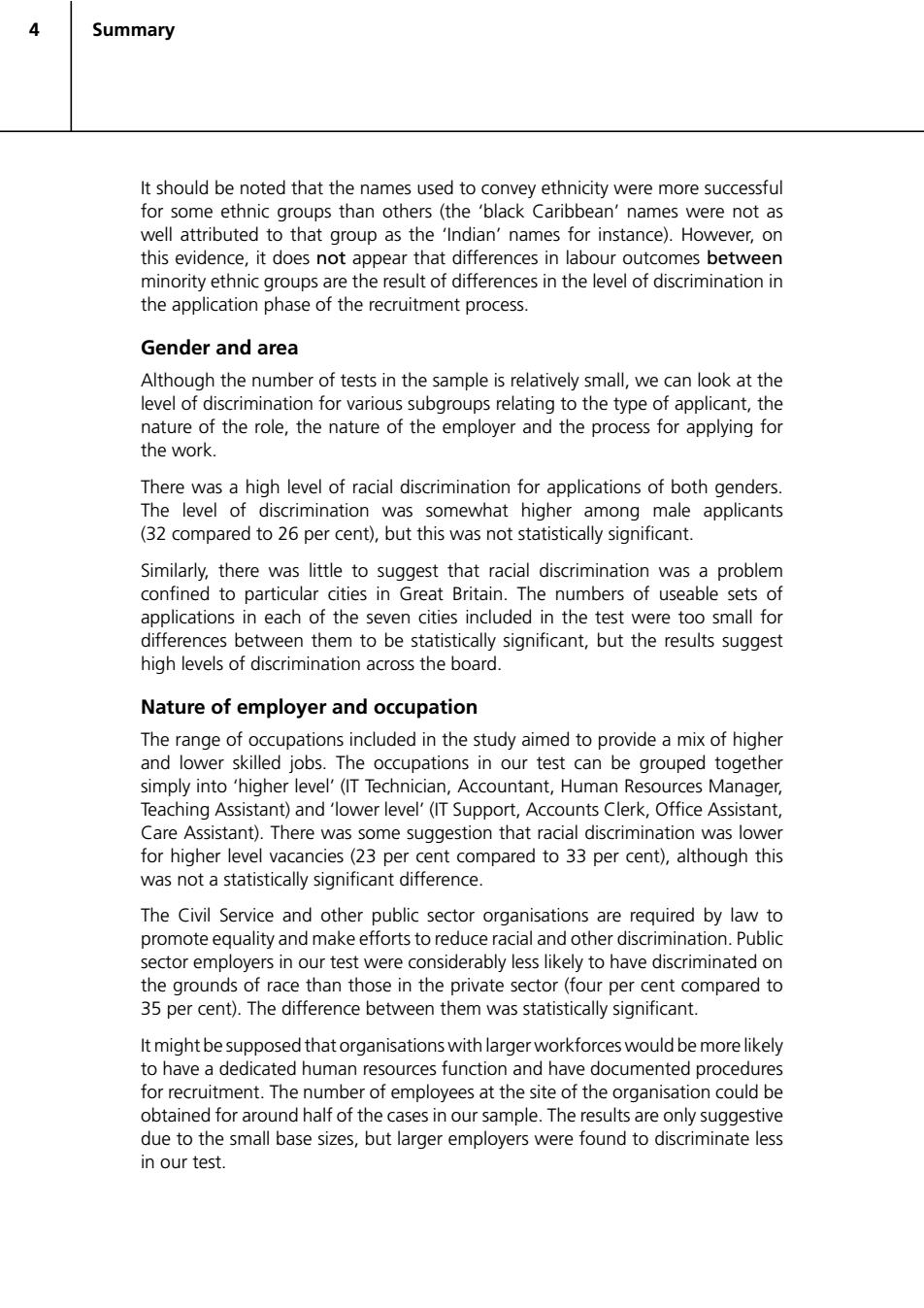正在加载图片...

Summary It should be noted that the names used to convey ethnicity were more successful for some ethnic groups than others(the 'black Caribbean'names were not as well attributed to that group as the 'Indian'names for instance).However,on this evidence,it does not appear that differences in labour outcomes between minority ethnic groups are the result of differences in the level of discrimination in the application phase of the recruitment process. Gender and area Although the number of tests in the sample is relatively small,we can look at the level of discrimination for various subgroups relating to the type of applicant,the nature of the role,the nature of the employer and the process for applying for the work. There was a high level of racial discrimination for applications of both genders. The level of discrimination was somewhat higher among male applicants (32 compared to 26 per cent),but this was not statistically significant. Similarly,there was little to suggest that racial discrimination was a problem confined to particular cities in Great Britain.The numbers of useable sets of applications in each of the seven cities included in the test were too small for differences between them to be statistically significant,but the results suggest high levels of discrimination across the board. Nature of employer and occupation The range of occupations included in the study aimed to provide a mix of higher and lower skilled jobs.The occupations in our test can be grouped together simply into 'higher level'(IT Technician,Accountant,Human Resources Manager, Teaching Assistant)and 'lower level'(IT Support,Accounts Clerk,Office Assistant, Care Assistant).There was some suggestion that racial discrimination was lower for higher level vacancies(23 per cent compared to 33 per cent),although this was not a statistically significant difference. The Civil Service and other public sector organisations are required by law to promote equality and make efforts to reduce racial and other discrimination.Public sector employers in our test were considerably less likely to have discriminated on the grounds of race than those in the private sector(four per cent compared to 35 per cent).The difference between them was statistically significant. It might be supposed that organisations with larger workforces would be more likely to have a dedicated human resources function and have documented procedures for recruitment.The number of employees at the site of the organisation could be obtained for around half of the cases in our sample.The results are only suggestive due to the small base sizes,but larger employers were found to discriminate less in our test.4 It should be noted that the names used to convey ethnicity were more successful for some ethnic groups than others (the ‘black Caribbean’ names were not as well attributed to that group as the ‘Indian’ names for instance). However, on this evidence, it does not appear that differences in labour outcomes between minority ethnic groups are the result of differences in the level of discrimination in the application phase of the recruitment process. Gender and area Although the number of tests in the sample is relatively small, we can look at the level of discrimination for various subgroups relating to the type of applicant, the nature of the role, the nature of the employer and the process for applying for the work. There was a high level of racial discrimination for applications of both genders. The level of discrimination was somewhat higher among male applicants (32 compared to 26 per cent), but this was not statistically significant. Similarly, there was little to suggest that racial discrimination was a problem confined to particular cities in Great Britain. The numbers of useable sets of applications in each of the seven cities included in the test were too small for differences between them to be statistically significant, but the results suggest high levels of discrimination across the board. Nature of employer and occupation The range of occupations included in the study aimed to provide a mix of higher and lower skilled jobs. The occupations in our test can be grouped together simply into ‘higher level’ (IT Technician, Accountant, Human Resources Manager, Teaching Assistant) and ‘lower level’ (IT Support, Accounts Clerk, Office Assistant, Care Assistant). There was some suggestion that racial discrimination was lower for higher level vacancies (23 per cent compared to 33 per cent), although this was not a statistically significant difference. The Civil Service and other public sector organisations are required by law to promote equality and make efforts to reduce racial and other discrimination. Public sector employers in our test were considerably less likely to have discriminated on the grounds of race than those in the private sector (four per cent compared to 35 per cent). The difference between them was statistically significant. It might be supposed that organisations with larger workforces would be more likely to have a dedicated human resources function and have documented procedures for recruitment. The number of employees at the site of the organisation could be obtained for around half of the cases in our sample. The results are only suggestive due to the small base sizes, but larger employers were found to discriminate less in our test. Summary